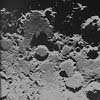 |
Houston TX (SPX) Sep 07, 2005 When humans return to the Moon and venture beyond, they'll get around using "smart" rovers that do much more than move cargo. The single-use rovers of the past will be replaced by multi-use planetary rovers that are full-fledged members of "EVA squads," humans and robots working together. The rovers will be able to transport both astronauts and equipment, follow verbal commands and hand signals, take direction by wireless remote control, act as communication and video relay stations and carry extra supplies. They'll even be able to do some work autonomously or with other robots. That's the focus of ongoing research by NASA's Science Crew Operations and Utility Testbed (SCOUT) project. Although lunar rovers were used on three Apollo missions, significantly expanding the exploration range of the astronauts, more capable vehicles will be needed to support the build-up, maintenance and exploration envisioned for prolonged lunar and Martian surface missions. The SCOUT rover will be taken for another test drive in September as part of tests in the Arizona desert near Flagstaff. Recently, at NASA's Johnson Space Center, spacesuited drivers, astronauts, operations personnel and engineers put the two-person SCOUT through its paces in a series of mid-year field tests. The results could help pave the way for building and maintaining bases, establishing resource depots and conducting scientific research, said Project Manager Frank Delgado of JSC's Engineering Automation, Robotics and Simulation Division. "The rover performed exceptionally well during all modes of operation. We were able to successfully carry out all our test objectives and learned valuable information about each of the subsystems," Delgado said. "This information will allow us to develop a more robust rover with even greater capabilities." Experts in automation and robotics, crew accommodations, power systems, avionics, structures, navigation, software systems, communication systems and operations developed SCOUT to test advanced technologies and operations concepts. The rover configuration can transport two suited astronauts, traverse 10-degree slopes equal to 30-degree slopes on Mars gravity, drive at speeds up to 7 mph, go over one-foot-tall rocks, and provide a six-mile driving range. The recent tests at JSC evaluated SCOUT in all three of its drive modes: onboard, teleoperation and autonomous. Onboard astronauts can use a display and control system with joystick ergonomically designed for two spacesuited astronauts riding in open cockpit seats. Astronauts also can drive the rover from afar using a teleoperation system that provides remote operators the same information they would have in the open cockpit. Or, they could employ an onboard "autopilot" that allows SCOUT to function with little or no human interaction, driving itself between previously defined waypoints, avoiding obstacles and using a stereo vision system to track and follow a nearby astronaut. The upcoming tests in the high desert of Arizona will evaluate SCOUT's autonomous and semi-autonomous capabilities, try out different cockpit designs for space-suited operators and develop a way to recharge spacesuit breathing air, batteries and cooling water on the move. Future enhancements to the rover will be developed using new ideas for intelligent software, crew accommodations, operations models, portable power solutions, communication technologies and in-situ processing. Email This Article
Related Links  Cambridge, England (AFP) Sep 06, 2005
Cambridge, England (AFP) Sep 06, 2005An experimental European probe has spotted a tiny area on the Moon that could be a promising site to set up a future manned outpost, a mission scientist said here Tuesday. |
|
| The content herein, unless otherwise known to be public domain, are Copyright 1995-2006 - SpaceDaily.AFP and UPI Wire Stories are copyright Agence France-Presse and United Press International. ESA PortalReports are copyright European Space Agency. All NASA sourced material is public domain. Additionalcopyrights may apply in whole or part to other bona fide parties. Advertising does not imply endorsement,agreement or approval of any opinions, statements or information provided by SpaceDaily on any Web page published or hosted by SpaceDaily. Privacy Statement |